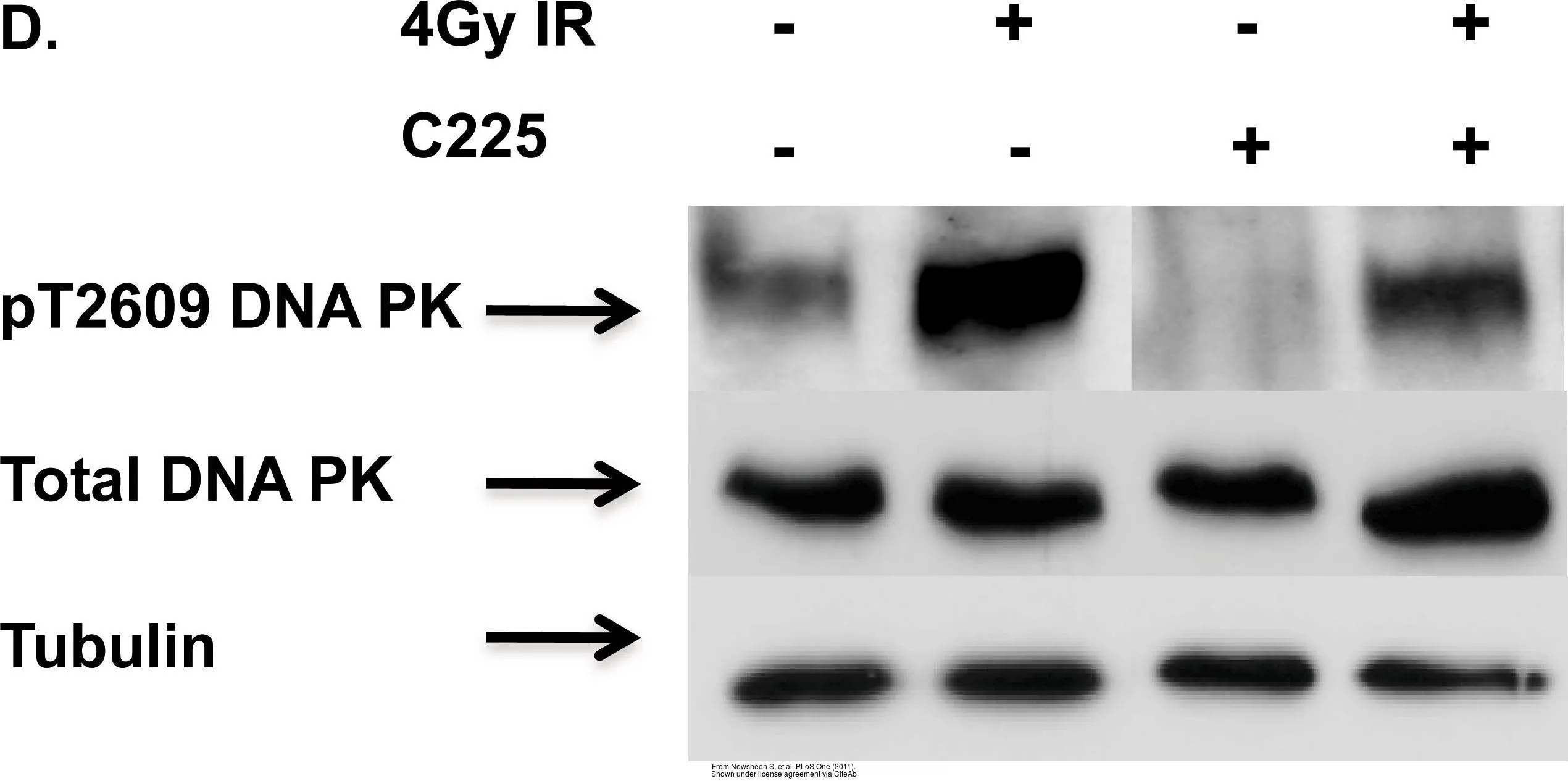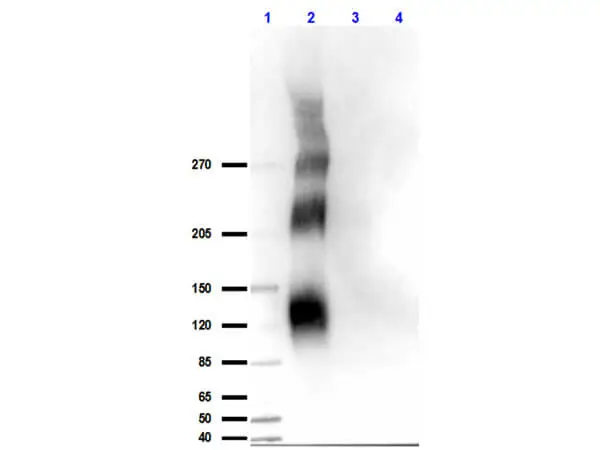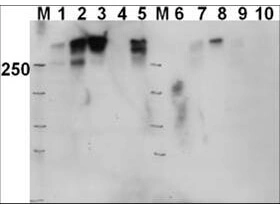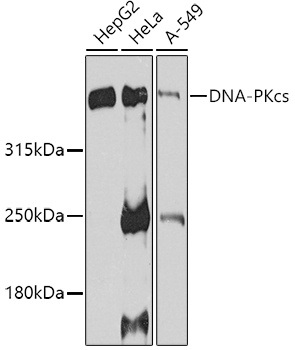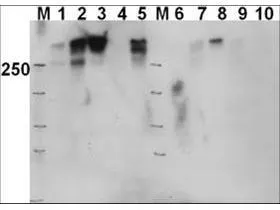
Western blot using GeneTex Affinity Purified anti-DNAPKcs antibody (GTX24194) shows detection of a 460 kDa band corresponding to human DNAPKcs in various preparations. Lane 1: Fus1 untreated Lane 2: Fus1 IR (20Gy, 4h) Lane 3: Fus1 DNAPK inhibitor + IR Lane 4: MO59J (DNAPK-) untreated Lane 5: MO59J IR Lane 6: Fus1 untreated Lane 7: Fus1 IR (20Gy, 4h) Lane 8: Fus1 DNAPK inhibitor + IR Lane 9: MO59J untreated Lane 10: MO59J IR. Lanes 1-5 are nuclear extract whereas lanes 6-10 are whole cell lysates. MO59J is a cell line that lacks DNA-PKcs. FUS1 is the matched cell line complemented with a chromosomal fragment containing the DNA-PKcs gene. Approximately 20 microg of lysate was run on SDS-PAGE and transferred onto nitrocellulose, followed by reaction with a 1:1,000 dilution of anti-DNAPKcs antibody. Detection occurred using a 1:5,000 dilution of HRP-labeled Goat anti-Rabbit IgG for 1 hour at room temperature. A chemiluminescence system was used for signal detection (Roche) using a 1 min exposure time.
DNA-PKcs (phospho Thr2609) antibody
GTX24194
ApplicationsImmunoFluorescence, ImmunoPrecipitation, Western Blot, ELISA, ImmunoCytoChemistry
Product group Antibodies
TargetPRKDC
Overview
- SupplierGeneTex
- Product NameDNA-PKcs (phospho Thr2609) antibody
- Delivery Days Customer9
- Application Supplier NoteWB: 1:500-1:2000. ELISA: 1:300000. *Optimal dilutions/concentrations should be determined by the researcher.Not tested in other applications.
- ApplicationsImmunoFluorescence, ImmunoPrecipitation, Western Blot, ELISA, ImmunoCytoChemistry
- CertificationResearch Use Only
- ClonalityPolyclonal
- Concentration1 mg/ml
- ConjugateUnconjugated
- Gene ID5591
- Target namePRKDC
- Target descriptionprotein kinase, DNA-activated, catalytic subunit
- Target synonymsDNA-PKC, DNA-PKcs, DNAPK, DNAPKc, DNPK1, HYRC, HYRC1, IMD26, S473K, XRCC7, p350, DNA-dependent protein kinase catalytic subunit, DNA-PK catalytic subunit, hyper-radiosensitivity of murine scid mutation, complementing 1, p460, protein kinase, DNA-activated, catalytic polypeptide, ser-473 kinase
- HostRabbit
- IsotypeIgG
- Protein IDP78527
- Protein NameDNA-dependent protein kinase catalytic subunit
- Scientific DescriptionDNA PK is the key component of the non-homologous end-joining (NHEJ) pathway of DSB repair in mammalian cells. DNA PK consists of a heterodimeric DNA-binding subunit (Ku70/80) and an approximately 465 kDa catalytic subunit (DNA PKcs). DNA PKcs is a serine/threonine protein kinase whose activity is greatly stimulated by its recruitment to DNA breaks by the Ku heterodimer.
- Storage Instruction-20°C or -80°C,2°C to 8°C
- UNSPSC12352203
References
- Lin RC, Chao YY, Lien WC, et al. Polo‑like kinase 1 selective inhibitor BI2536 (dihydropteridinone) disrupts centrosome homeostasis via ATM‑ERK cascade in adrenocortical carcinoma. Oncol Rep. 2023,50(3):pii: 167. doi: 10.3892/or.2023.8604.Read this paper
- Nixon BR, Sebag SC, Glennon MS, et al. Nuclear localized Raf1 isoform alters DNA-dependent protein kinase activity and the DNA damage response. FASEB J. 2019,33(1):1138-1150. doi: 10.1096/fj.201800336RRead this paper
- Jarboe JS, Anderson JC, Duarte CW, et al. MARCKS regulates growth and radiation sensitivity and is a novel prognostic factor for glioma. Clin Cancer Res. 2012,18(11):3030-41. doi: 10.1158/1078-0432.CCR-11-3091Read this paper
- Jarboe JS, Jaboin JJ, Anderson JC, et al. Kinomic profiling approach identifies Trk as a novel radiation modulator. Radiother Oncol. 2012,103(3):380-7. doi: 10.1016/j.radonc.2012.03.014Read this paper
- Nowsheen S, Bonner JA, Lobuglio AF, et al. Cetuximab augments cytotoxicity with poly (adp-ribose) polymerase inhibition in head and neck cancer. PLoS One. 2011,6(8):e24148. doi: 10.1371/journal.pone.0024148Read this paper

